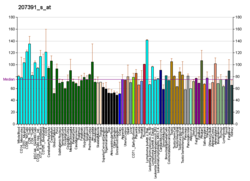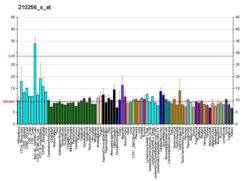| PIP5K1A |
|---|
|
| Identifiers |
|---|
| Aliases | PIP5K1A, phosphatidylinositol-4-phosphate 5-kinase type 1 alpha |
|---|
| External IDs | OMIM: 603275; MGI: 107929; HomoloGene: 93492; GeneCards: PIP5K1A; OMA:PIP5K1A - orthologs |
|---|
| Gene location (Human) |
|---|
 | | Chr. | Chromosome 1 (human)[1] |
|---|
| | Band | 1q21.3 | Start | 151,197,949 bp[1] |
|---|
| End | 151,249,536 bp[1] |
|---|
|
| Gene location (Mouse) |
|---|
 | | Chr. | Chromosome 3 (mouse)[2] |
|---|
| | Band | 3|3 F2.1 | Start | 95,058,530 bp[2] |
|---|
| End | 95,106,930 bp[2] |
|---|
|
| RNA expression pattern |
|---|
| Bgee | | Human | Mouse (ortholog) |
|---|
| Top expressed in | - right testis
- epithelium of colon
- left testis
- sural nerve
- Achilles tendon
- gastric mucosa
- skin of leg
- left uterine tube
- skin of abdomen
- islet of Langerhans
|
| | Top expressed in | - gastrula
- Rostral migratory stream
- decidua
- olfactory tubercle
- cumulus cell
- CA3 field
- dentate gyrus
- pineal gland
- dentate gyrus of hippocampal formation granule cell
- primary motor cortex
|
| | More reference expression data |
|
|---|
| BioGPS | 
 | | More reference expression data |
|
|---|
|
| Gene ontology |
|---|
| Molecular function | - transferase activity
- nucleotide binding
- 1-phosphatidylinositol-4-phosphate 5-kinase activity
- kinase activity
- kinase binding
- protein binding
- phosphatidylinositol phosphate kinase activity
- ATP binding
- 1-phosphatidylinositol-3-phosphate 5-kinase activity
- 1-phosphatidylinositol-5-kinase activity
- phosphatidylinositol-3,4-bisphosphate 5-kinase activity
- 1-phosphatidylinositol-3-phosphate 4-kinase activity
| | Cellular component | - nuclear speck
- mRNA cleavage and polyadenylation specificity factor complex
- cell projection
- membrane
- focal adhesion
- ruffle
- plasma membrane
- nucleoplasm
- ruffle membrane
- nucleus
- lamellipodium
- cytoplasm
- cytosol
| | Biological process | - fibroblast migration
- actin cytoskeleton reorganization
- phosphatidylinositol metabolic process
- activation of GTPase activity
- phosphorylation
- keratinocyte differentiation
- focal adhesion assembly
- phospholipid biosynthetic process
- phagocytosis
- cell chemotaxis
- glycerophospholipid metabolic process
- ruffle assembly
- cell migration
- signal transduction
- phosphatidylinositol phosphate biosynthetic process
- regulation of phosphatidylinositol 3-kinase signaling
- phosphatidylinositol biosynthetic process
- protein localization to plasma membrane
| | Sources:Amigo / QuickGO |
|
| Orthologs |
|---|
| Species | Human | Mouse |
|---|
| Entrez | | |
|---|
| Ensembl | | |
|---|
| UniProt | | |
|---|
| RefSeq (mRNA) | |
|---|
NM_001135636
NM_001135637
NM_001135638
NM_003557
NM_001330689 |
| |
|---|
| RefSeq (protein) | |
|---|
NP_001129108
NP_001129109
NP_001129110
NP_001317618
NP_003548 |
| |
|---|
| Location (UCSC) | Chr 1: 151.2 – 151.25 Mb | Chr 3: 95.06 – 95.11 Mb |
|---|
| PubMed search | [3] | [4] |
|---|
|
| Wikidata |
| View/Edit Human | View/Edit Mouse |
|


















